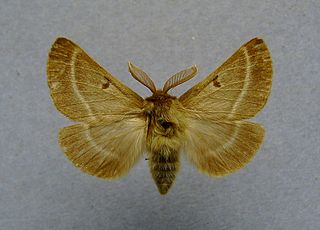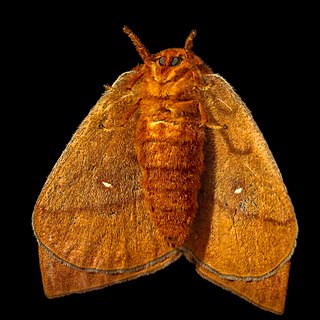
Bombycoidea is a superfamily of moths. It contains the silk moths, giant silk moths, sphinx moths, and relatives. The Lasiocampoidea are close relatives and were historically sometimes merged in this group. After many years of debate and shifting taxonomies, the most recent classifications treat the superfamily as containing 10 constituent families. Their larvae often exhibit horns.

Brahmaeidae is a family of insects in the order Lepidoptera, commonly known as Brahmin moths. It includes species formerly included in the family Lemoniidae.

The Bombycidae are a family of moths. The best-known species is Bombyx mori (Linnaeus), or silkworm, native to northern China and domesticated for millennia. Another well-known species is Bombyx mandarina, also native to Asia.

Lemonia balcanica is a species of moth of the family Brahmaeidae. It is found in the Balkans.

Lemonia philopalus is a species of moth of the family Brahmaeidae. It is found from Spain up to Egypt and North Africa.
Saturnia mendocino, the Mendocino saturnia moth, is a species of silkmoth in the family Saturniidae. It was first described by Behrens in 1876 and it is found in North America.

Hemileuca burnsi, the Burns' buckmoth, is a species of insect in the family Saturniidae. It is found in North America.
Automeris cecrops, the cecrops eyed silkmoth, is a species of insect in the family Saturniidae. It is found in Central America and North America.
Hemileuca stonei, the pangola-grass moth or Stone's buckmoth, is an insect in the family Saturniidae. The species was first described by Claude Lemaire in 1993. It is found in Central and North America.
Saturnia albofasciata, the white-streaked saturnia moth, is a species of silkmoth in the family Saturniidae.
Automeris iris, the iris eyed silkmoth, is a species of insect in the family Saturniidae. It is found in Central America and North America.
Hemileuca oliviae, the range caterpillar, is a species of insect in the moth family Saturniidae. It is found in Central America and North America.

Hemileuca juno, the Juno buck moth, is an insect in the family Saturniidae. The species was first described by Alpheus Spring Packard in 1872. It is found in Central and North America.
Hylesia coinopus is a species of insect in the moth family Saturniidae. It is found in Central America and North America.
Saturnia walterorum, or Walter's saturnia moth, is a species of silkmoth in the family Saturniidae. It is found in Central America and North America.
Anisota manitobensis, the Manitoba oakworm moth, is a species of royal moth in the family Saturniidae. It is found in North America, primarily Manitoba.
Coloradia luski, or Lusk's pine moth, is a species of insect in the family Saturniidae. It was first described by William Barnes and Foster Hendrickson Benjamin in 1926 and it is found in North America.
Hemileuca grotei, or Grote's buck moth, is a species of insect in the family Saturniidae. It is found in North America.

Anisota consularis, the Florida oakworm moth or consular oakworm moth, is a moth in the family Saturniidae. The species was first described by Harrison Gray Dyar Jr. in 1896. It is found in North America.
Hemileuca griffini, known generally as the Griffin's sheepmoth or Canadian fleabane moth, is a species of insect in the family Saturniidae. It is found in North America.
This page is based on this
Wikipedia article Text is available under the
CC BY-SA 4.0 license; additional terms may apply.
Images, videos and audio are available under their respective licenses.








